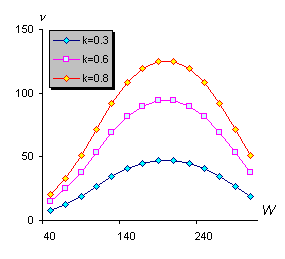|
Mathematical model > Model of cardiac output regulation
|
Model of cardiac output regulation
The system of correlations (12) - (19) given here is a basis of our blood circulation model. These correlations are represented as an original formalization of Frank-Starling's heart law and describe the heart as a nonlinear oscillatory system.
The heart in our mathematical model is considered as a pump. The most important pump characteristics are: the values of systolic ventricular pressure Pi, cardiac cycle duration T and output ventricular volumes vi.
Let us designate {τn}, n = 0,1,... - the moments sequence of cardiac cycle beginning (the beginning of ventricular systole), Tn = τn - τn-1 - sequence of cardiac cycle durations .
Let us write down correlations for Frank-Starling's heart law [15], that evaluates a dependence of ventricular output vi from its filling at the start moment of heart compression cycle (enddiastolic volume) Wi:
 |
 |
(12) |
where values ki are named as ventricular inotropic factors, bell-kind function
 |
(12.1) |
where values Ni, ui, α, β1, β2 are approximation constants and selected experimentally.
|
|||
|
For inotropic factor we have a dependence (54) from inotropic condition ki and neurohumoral factor γ.
The correlations, similar to (12) , written separately for left and right ventricles, are given in the works of Amosov N. M. with co-authors [12]. Equations for ventricular output (12) are used in our model for definition of systole-diastole jump conditions (1-2-jump). As the ventricular output volume is determined as a difference between enddiastolic and endsystolic volumes, endsystolic ventricular volume win from (12) is defined as
 |
(13) |
whence 1-2-jump conditions in cardiac n-cycle are determined by correlations
 |
(14) |
In our model the cardiac cycle duration ÑÊ is defined as a value, reciprocally proportional to the value of neurohumoral factor γ in the moment of previous cycle ending
 |
(15) |
Correlations (15) are used for definition of systole-diastole jump conditions (2-1-jump)
 |
(16) |
The necessary value of ventricular output is provided with control by the value of average systolic ventricular pressure Pi . This control is in turn provided with a principle of negative feedback on misalignment between actual and nominal systolic duration. Nominal duration of ventricular systole θin in the work [12] is determined through inotropic ventricular factor ki by this formula
 |
(17) |
where a, b – empirical constants of an approximation .
Actual systolic duration σin is determined as a moment of equality (14) execution . Misalignment between actual and nominal systolic duration in n-cycle
 |
(18) |
In our model the value of average systolic ventricular pressure Pin+1 in n+1-cycle is defined through the value of average systolic pressure Pin in n-cycle by a recursive ratio
 |
(19) |
Equation (19) claims, that average systolic ventricular pressure is constant during each systoleó. Under transition to the following cardiac cycle it is recalculated according to (19). The equation sets the control algorithm of systolic ventricular pressure depending on the value Δin and factors of sensitivity si . In the work [9] the important role of values si for existence and periodic movement stability of dynamic system (1) is given .
Mathematical model > Model of cardiac output regulation
References on the topic:
© Samara-Dialog Ltd. 2004-2009 |
